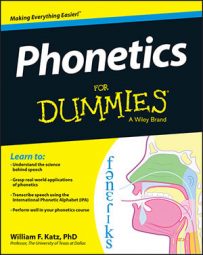What produces speech: Your speech anatomy
A source-filter system produces human speech. Speech begins with a breathy source. The airflow beginning at the lungs causes sound to be produced through vibration and hissiness at the larynx (also referred to as your voicebox) in your throat. You then shape this sound through a filter, the passageways of the mouth and nasal cavity (nose). As you move your tongue around in your mouth to different areas, different tube-like vocal tract shapes are created. These shapes result in different sounds. Here are some important terms related to speech anatomy:
-
Alveolar ridge: A bony ridge at the roof of your mouth about a half-inch behind your upper teeth.
-
Glottis: The hole (or space) between the vocal folds in your throat.
-
Larynx: Also referred to as the Adam’s apple, it’s the voice box made of cartilage in your throat that holds your vocal folds.
-
Lips: Important for forming consonants such as in “pat,” “bat,” “mat,” “fat,” “vat,” and “wet”. They’re protruded for some vowels.
-
Palate: Roof of the mouth, divided into hard palate (front) and soft palate (back).
-
Pharynx: A tube that connects the larynx to the oral cavity (mouth), located at the far back of your throat.
-
Teeth: Used to make dental sounds such as /θ/ in “teeth” and /ð/ in “those”
-
Tongue: The most important organ of speech production. A large muscle capable of amazing shape changes, used for speech and feeding.
-
Uvula: A dangling piece of tissue at the very end of the soft palate (the velum) that can act as a place of articulation for consonants in many languages
-
Velum: Another name for the soft palate, the back part of the roof of the mouth that is not supported by bony cartilage.
-
Vocal folds: Also known as the vocal cords, they’re two small flaps of muscle (about a half-inch long) in the larynx that vibrate and create speech.
How consonants are formed: The manner of articulation
You make consonants by completely or partially blocking airflow during speech. You can do this in different ways: you can completely block airflow, push air through a groove or slit to make a hissing sound, block air then make a hiss, or bring the speech articulators (the organs of speech) close together to shape sound. The result is different manners of articulation (different ways of making a sound). You need to be able to label all these processes in order to work with speech in a clinical or educational setting. Here are some key terms for consonant manner of articulation.
-
Affricate: A stop followed by a fricative with the same place of articulation, such as /ʧ/ as in “chip” and /ʤ/ as in “germ.”
-
Approximant: A sound made by bringing articulators together to shape airflow, while not blocking air or causing hissing. Examples include “read,” “weed,” “lead,” and “you.”
-
Flap: A rapidly made stop consonant, usually voiced, such as the “t” in “Betty” as pronounced in American English
-
Fricative: A hissy consonant, such as in “fat,” “vat,” “thick,” “this,” “sip,” “zip,” “ship,” and “leisure”. It’s made by producing friction in the airstream.
-
Glide: A subgroup of the approximants, also called semivowels, including the sounds /j/ as in “you” and /w/ as in “we”.
-
Lateral: Sounds made by directing airflow around the sides of the tongue, such as /l/ in “listen”.
-
Liquid: The other two English approximants (besides glides), /l/ and /ɹ/.
-
Nasal: Sounds produced with airflow escaping through the nasal passage, such as in “meat,” “neat,” and “sing“.
-
Stop: Also known as plosive, a sound made with complete closure of the oral cavity.
How vowels are formed: Some basic vowel types in phonetics
You make vowels in a different way than consonants. Vowels don’t involve air blockage, but instead require a more continual sound flow and sound shaping. Phoneticians describe vowel production in terms of HAR:
-
Height (whether the tongue is high, mid, or low in the mouth)
-
Advancement (how front or back the tongue is)
-
Rounding (whether the lips are protruded, for sounds like the “oo” of “boot.”)
Another way is to consider place of articulation (where in the mouth the tongue is place) and manner of articulation (how the sound is made) features. Here are some key manners of articulation terms for consonants:
-
Cardinal vowels: Anchor points worked out by the phonetician Daniel Jones to help people classify vowels. Cardinal vowels are special vowels, not really found in any world languages, that phoneticians use for ear training to later detect small differences in sound quality between real-world examples.
-
Diphthong: Sounds that glides from one vowel to another, such as in “cow,” “boy,” and “fight”. These sounds are made with two tongue positions.
-
Lax/tense: An important grouping describing two phonological classes of vowels:
-
Lax vowels can only appear in stressed, closed syllables (ending with a consonant).
-
Tense vowels can also be in open syllables.
-
-
Monophthong: A vowel with a single sound quality, such as the middle sound in “rat” or “bit”. These sounds are made with one tongue position.
-
Rhotic: Also referred to as r-coloring, rhotic means there is an “r” like sound present, such as the vowel sounds in “fear,” “fare,” “far,” and “for“.
-
Schwa: A mid-central, unrounded vowel [ə] that is poorly named because it rhymes with “duh”.

